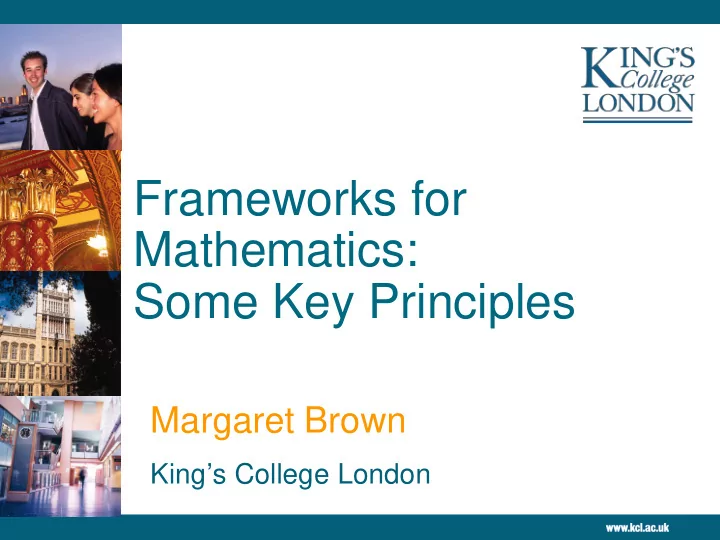

Frameworks for Mathematics: Some Key Principles Margaret Brown King’s College London
1) Understanding/connections and processes/practices generally progress; facts and procedures come and go. 2
Low attaining Y3 children’s recall of 4+5 or 5+3 after 5 days’ teaching Ch Je Pe Dn Jy Th Ph √ √ 1 day √ 1 week 5 mths √ 10mths √ √ √ √ 18mths Denvir & Brown (1986b) 3
CSMS: Adding fractions (1977) Year 7 Year 8 Year 9 Year 10 1 + 1 = 54% 38% 35% 45% 3 4 43% 25% 23% 24% 32 + 5 = 2 1 3 4 5 = ? 66% 68% 71% 75% 10 30 2 = _? 59% 58% 63% 64% 3 15 4
2) Long-term learning of facts & procedures is underpinned by understanding/ connections (and especially actions and images) 5
Numeracy Learning Hierarchy (Denvir & Brown, 1986) 6
So… - Should threshold assessment mainly assess understanding & application of key ideas or facts and procedures? - Can we easily classify questions as testing either facts/procedures or understanding – doesn’t the balance depend on the learner’s knowledge? 7
3) Developing connections takes time, more for some than others. Armchair curriculum designers depending on logic rather than empirical evidence can have a rose-tinted view (memory?) of what students might know and how fast can learn. 8
120 100 Success rate (%) 80 60 40 20 0 1O 1J 2O 2J 3O 3J 4O 4J 5O 5J 6O 6J Test administration(Yeargroup/month) Apples 1<200
Number (Place-value and decimals): 2008-9
Evidence from US Common Core (adapted from Hirsch) In New York City/NY State, testing on new curriculum for grades 3-8 began in 2013 (most of rest of country follows in 2015) 30% /31% passed maths (down from 60%/65%) In NYC, 15% African Americans & 19% Hispanics passed (9 schools with no passes) 11
So… - Can we zoom in to describe empirically small progressive steps which lead to greater fluency and application (e.g. NNS framework) without leading to an over-detailed and fragmented curriculum? - How loosely age-related should the framework be? 12
4) Processes/practices progress according to complexity of mathematical content and application (e.g. type and number of variables). 13
So….. How can progression in problem-solving best be described? 14
A few minor quibbles… - Isn’t measurement always about numbers, but only sometimes about spatial quantities? - Isn’t logic a branch of mathematics, not just a mathematical practice? - Should processes be identified with stages in modelling? 15
And finally… Can we please have a curriculum which looks forward to the realities of the mid- 21 st century rather than backwards to the 19 th (whatever they choose to do in Singapore and Shanghai)? 16
17
PIMS results on measurement (Brown et al, 1996) Gp 1 Gp 2 Gp 3 Gp 4 Gp 5 Gp 6 Gp 7 (14-20) (23-32) (32-40) (40-47) (49-56) (56-66) (76) Year 8 2 4 4 1 Year 6 2 2 4 3 Year 4 1 3 4 2 Year 2 3 3 3 1 1 3 primary schools & 2 secondary schools, all middle- performing schools. 6 pupils representing a range from each year group. Practical interview on measuring length and mass. Performance groups based on types of response (scores out of 80) 18
Level 0 Level 1 Level 2 Level 3 Level 4 Level 5 Level 6 1977 7% 9% 17% 23% 12% 16% 16% 2008/9 15% 3% 16% 17% 26% 12% 12%
: Mean increase in success rate on common items since the previous test From To Increase Year 1 Oct Year 1 Jun +20% Year 1 Jun Year 2 Oct + 5% Year 2 Oct Year 2 Jun +20% Year 2 Jun Year 3 Oct + 2% Year 3 Oct Year 3 Jun +13% Year 3 Jun Year 4 Oct + 2% Year 4 Oct Year 4 Jun +10% Year 4 Oct Year 4 Jun + 10% Year 4 Jun Year 5 Oct + 5% Year 5 Oct Year 5 Jun +11% Year 5 Jun Year 6 Oct + 4% Year 6 Oct Year 6 Jun +11% Year 6 Jun Year 7 Jun - 2%*
100 90 80 70 4x5 60 50 9x9 40 7x8 30 20 10 0 1O 1J 2O 2J 3O 3J 4O 4J 5O 5J 6O 6J Test Administration(Yr gp/month)
Combined 15 Cohort 2 Cohort 1 Cohorts 14 13 12 11 10 9 8 7 6 5 4 3 2 Y1 Oct 98 Y1 Jun99 Y2 Oct 99 Y2 Jun00 Y3 Oct 00 Y3 Jun01 Y4 Oct Y4 Jun Y5 Oct 98 Y5 Jun99 Y6 Oct 99 Y6 Jun00 Y1 to Y6 Progression (Y4 Cohort combined)
Joseph’s progression in terms of numeracy age, in relation to his class and the sample (Cohort2) 15 Child 14 Class Mean 13 12 11 10 9 8 7 6 5 Y4 Oct 97 Y4 Jun98 Y5 Oct 98 Y5 Jun99 Y6 Oct 99 Y6 Jun00
15 Child Debbie 14 Class Mean 13 12 11 10 9 8 7 6 5 Y4 Oct97 Y4 Jun98 Y5 Oct98 Y5 Jun99 Y6 Oct99 Y6 Jun00 Debbie (Cohort 2)
Recommend
More recommend